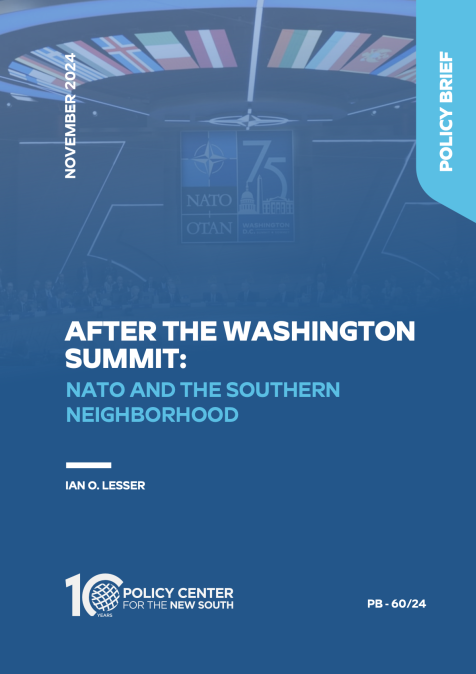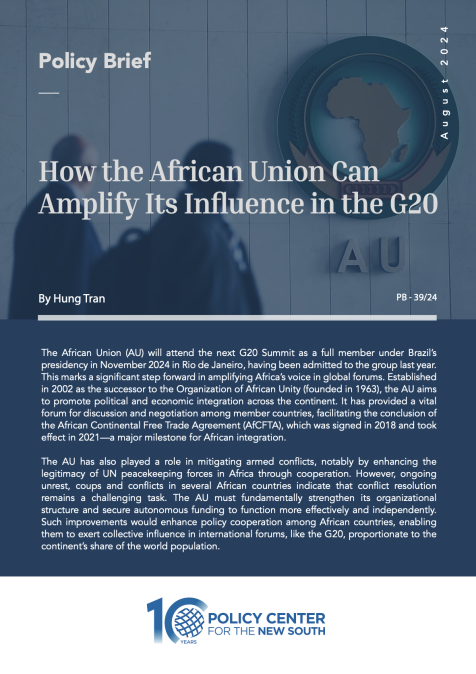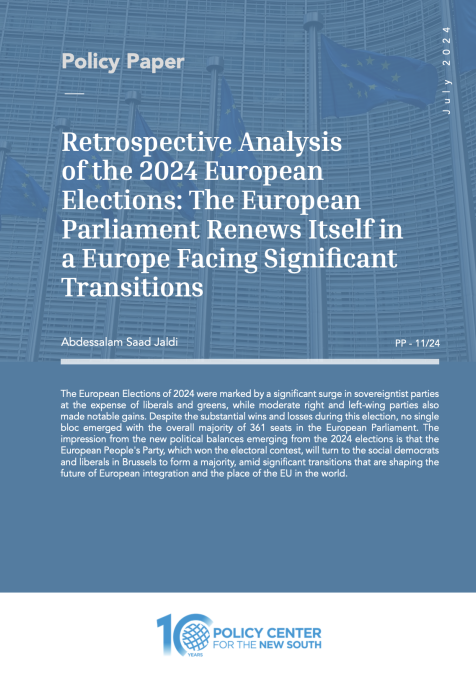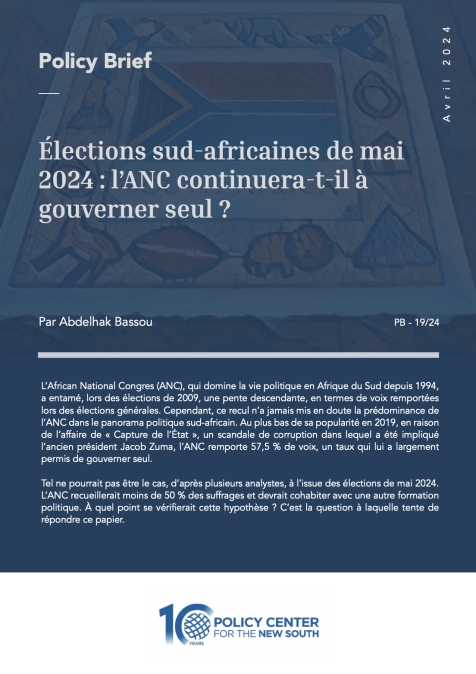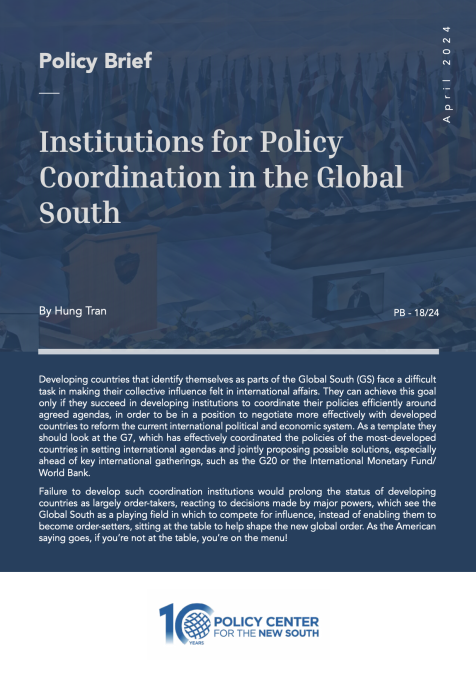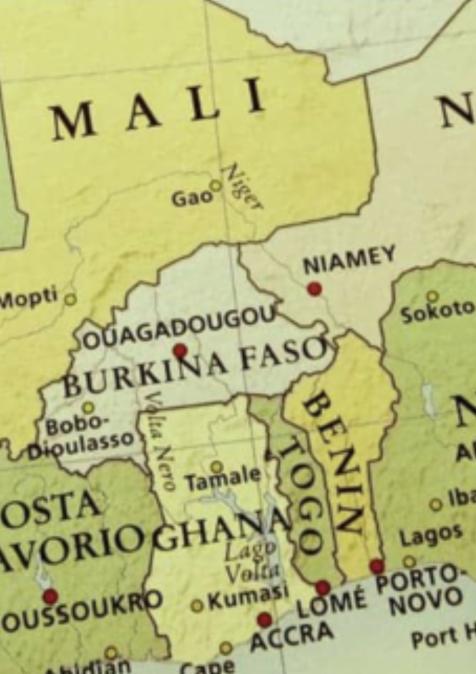Publications /
Policy Brief
At its Washington summit in July 2024, marking NATO’s 75th anniversary, the Alliance focused on strengthening deterrence and defense in response to the ongoing threat from Russia. The summit also addressed escalating risks from an increasingly assertive China, particularly regarding its support for Russia’s actions in Ukraine, underscoring partnerships in the Indo-Pacific with regional leaders in attendance. While Southern-oriented challenges and partnerships may not have been a central feature, closer analysis of the summit’s conclusions reveal a significant “southern” dimension. Despite a primary emphasis on the Eastern and Northern fronts, the summit highlighted a number of issues relevant to the Mediterranean, the Persian Gulf, Africa, and the southern Atlantic.
Introduction
Transatlantic partners are navigating a rapidly changing strategic environment around the Mediterranean, with notable risks along an extended southern flank that stretches from the Maghreb and the Sahel to the Levant, and from Africa to the Gulf. Ahead of the Washington summit, NATO’s eleven-member independent expert group on the southern neighborhood presented its report and recommendations to Secretary General Stoltenberg.[2] Several of these recommendations were incorporated into the summit’s conclusions, including the appointment of a NATO special representative for the Southern neighborhood.[3]
NATO’s strategic concept features three core tasks: deterrence and defense, crisis prevention and management, and cooperative security—all of which are relevant to the Alliance’s Southern strategy. Yet, as NATO confronts more immediate and potentially existential threats elsewhere, can it also develop an effective approach to its southern flank? What are the essential elements of NATO’s southern posture, and what elements should guide the Alliance’s strategy and partnerships across this region?[4]
A Perennial and Peripheral Theatre
Alliance politics and shifting regional security demands have long shaped NATO’s strategic priorities. From its inception, NATO’s focus has included the Eastern Mediterranean, where the Cold War brought threats of Soviet aggression and political subversion, prompting NATO’s first enlargement to Greece and Turkey. Since the Berlin blockade of 1948-1949, Euro-Atlantic partners have navigated a litany of crises emanating from the south. The list is long: the Suez crisis of 1956, the Arab-Israeli wars of 1967 and 1973, the Iran-Iraq War, two Gulf wars, the Balkan conflicts, 9/11 and two decades in Afghanistan, intervention in Libya, repeated conflicts in Lebanon, civil war in Syria, insurgencies and terrorism in the Sahel, and ongoing conflicts in Gaza and with Iran. These and other flashpoints have directly affected European and American security, through terrorism, the proliferation of sophisticated weapons and waves of refugees.
While NATO’s northern and central fronts were the center of gravity during the Cold War, these fronts were relatively stable. A structured framework of arms control and confidence-building measures maintained a predictable balance between NATO and the Warsaw Pact, mitigating the risk of direct confrontation at theatre and strategic levels.
Despite numerous crises and flashpoints, NATO’s southern flank has remained a secondary theatre in Alliance strategy. With limited exceptions, the Mediterranean and its surrounding regions have not presented a direct threat to NATO territory. Strategically, this theatre is divided among Europe, the Middle East and Africa, with distinct regional policies and bureaucratic responsibilities in allied capitals. While some military areas of responsibility do cross these lines, NATO’s southern region is generally managed as a series of largely separate policy domains.
The vast scale, complex geography and diverse risks across the region further complicate the picture. The distance from Dakar in Senegal to Turkey’s eastern border spans roughly 8,000 kilometers and encompasses a range of security challenges, from traditional military threats to insurgencies, civil wars, crime, terrorism and human security concerns tied to poverty, migration and natural disasters. The economic gap between northern and southern Mediterranean countries is second only to the divide on the Korean peninsula. Climate-related risks compound these challenges, and the region lacks a unifying threat or common adversary around which NATO can build a concerted strategy. While few southern threats are existential in strict security terms, several—particularly terrorism and migration—pose politically existential risks to national governments. Many of these challenges resist solutions based solely on military power, further driving varied perspectives within the Alliance. The ongoing instability in Libya illustrates these complexities, with member states like France, Italy and Turkey favoring rather different outcomes.
Risks Old and New
In the context of the ongoing conflict in Ukraine, multiple Middle Eastern crises and growing competition with China, several factors are likely to shape NATO’s strategy toward its southern flank. The conclusions from the Washington summit emphasize several key issues and tasks, all closely associated with the evolving strategic environment in the south.
One crucial dynamic is the nexus between security in the east and the south. These theatres are not isolated. Although the core of NATO’s rivalry with Russia is in the East and the North—focused on the Baltic, the Polish border, and the defense of Ukraine—other regions are part of this competition. The Black Sea, Western Balkans, Syria, Libya, the Sahel, and central Africa are all places where NATO and Russian interests clash. Russia’s diplomatic outreach to the Arab Gulf states and its expanding strategic cooperation with Iran further extend its influence in the South. Russia’s activism in the south also brings a degree of exposure for Russia. The March 2024 ISIS-K attack in Moscow highlighted Russia’s own vulnerability to blowback from its actions in the Middle East and Central Asia.
Despite Turkey’s complex economic ties and cautious relationship with Moscow, it remains acutely vulnerable to a potential military clash with Russia. The 2015 downing of a Russian fighter-bomber that crossed into Turkish airspace underscores the risk. Although that incident was contained, the potential for elation is far greater under today’s conditions. Across the Mediterranean, NATO and Russian forces regularly operate in close proximity, often with far less caution and transparency than during the Cold War, making the risks of accidents, misjudgments and unintended escalation all too real.
In addition to these military risks, Russia’s role in political manipulation, disinformation and malign finance is shaping the security environment across NATO’s south, including the political and media environment inside some member states. Through activities in the Western Balkans and arms sales to Syria, Egypt, Algeria and Iran, Russia contribute to Moscow’s influence, while Russian mercenaries remain active across the Sahel and central Africa. Although Russia’s conventional military power around the Mediterranean is limited outside of Syria, its broader geopolitical posture has significant implications, highlighting the inseparability of East and South in today’s strategic landscape. In the wider Atlantic, Russia’s support for Venezuela’s Maduro regime and its disinformation activities across Latin America challenge transatlantic political and security interests.
Second, NATO’s southern strategy is likely to be shaped by the evolving threat of terrorism and insurgencies targeting Europe, North America or regions with significant transatlantic interests. Al Qaeda and ISIS remain active forces, threatening stability across West Africa, the Horn of Africa, and the Levant. The war in Gaza could also incite new terrorist attacks in Europe and beyond, potentially shifting public and official perspectives on security priorities after years of focus on more conventional risks. This aspect of NATO’s southern exposure will affect not only the southern members of the Alliance. It may be felt most keenly in London, Paris, Berlin and Washington.
Third, the war in Ukraine has highlighted the vulnerability of population centers and infrastructure to ballistic and cruise missiles, and drone attacks. The Iran-Israel confrontation similarly underscores the potential for such threats across NATO’s southern flank. Cyprus, although not a NATO member, has faced threats from Hezbollah. Significant NATO air defense assets are already deployed in the Mediterranean, and can be repositioned as needed. Demands for such defenses will likely increase as state and non-state actors acquire systems with extended range and precision. The high level of urbanization around the Mediterranean, and the proximity of population and political centers drive the proliferation of stand-off weapons for both states and non-state actors. Counter-proliferation and integrated air defense will remain central priorities in NATO’s southern strategy.
Fourth, maritime security and the protection of Mediterranean infrastructure are poised to become significant elements of NATO’s southern strategy. Recent attacks on shipping in the Red Sea and Gulf of Aden have highlighted these risks, particularly in the Eastern Mediterranean, where Hezbollah in Lebanon and various non-state actors in Syria possess substantial capabilities to target merchant shipping, ports and energy facilities. This vulnerability also extends to critical undersea electrical and digital cables. The Mediterranean already serves as a hub for north-south connectivity with links extending to the Indo-Pacific. However, political and security risks in this region could deter investment and hinder future development. Addressing these risks will be essential to fostering stability and growth in this strategic sector.
Fifth, closer cooperation between NATO and the EU in the coming years will likely make the Mediterranean and its surrounding areas critical test cases for collaboration. The blend of hard and soft security challenges in this region creates promising conditions for joint efforts based on different but complimentary instruments. This cooperation will also entail transatlantic burden-sharing, as the region from West Africa to the Gulf is within reach for the power projection abilities of key European allies.. Unlike the eastern flank or Asia, where American power is critical and irreplaceable, the Mediterranean region is a practical sphere for European military influence. The U.S. presence in the area, particularly air and naval forces, has increased after decades of decline, yet Europe is better positioned to safeguard its interests here than in more distant theaters. If Europe cannot achieve a degree of “strategic autonomy” on its southern periphery, it will be difficult to realize it elsewhere. But the capacity for power projection is not just about operational capacity. The ongoing experience in the Red Sea shows the reluctance of some European states to engage decisively, even when the capabilities are in place.
Finally, NATO will remain essential for strategic stability, risk reduction and confidence-building within the Alliance, particularly in the Aegean and Eastern Mediterranean. NATO’s efforts in averting potential military conflict between Greece and Turkey through confidence-building measures and dialogue have been vital. The recent shift from dangerous brinkmanship to cautious détente between Athens and Ankara is due to multiple factors, but NATO’s role as a stabilizing anchor and facilitator has been crucial.
A Wealth of Assets
NATO has considerable assets in the South. This is very different from the situation in the East, where adapting NATO’s force posture and command structure for rapid response, high-intensity conventional defense, and nuclear deterrence has proven both demanding and costly. Excluding the Black Sea—often considered part of the Eastern security equation—the broader Mediterranean region is an area where NATO has long maintained a substantial force presence and well-established command structures. Costly new investments and additional structures should not be needed to address most of the pressing security challenges in this region.
Rethinking the “South”
In NATO discussions, the definition of the “South” remains vague. Historically, it referred to the Mediterranean and its hinterlands, stretching from Mauritania to the Persian Gulf—a concept rooted in partnership initiatives like the Mediterranean Dialogue launched in the 1990s and the later Istanbul Cooperation Initiative.[5] The Mediterranean Dialogue emerged during a time of optimism in the Middle East peace process and thrived in relatively stable conditions. Now, these conditions have changed in fundamental ways, complicating the outlook for multilateral dialogue. Despite this, NATO’s multi-bilateral model of cooperation has held firm, with practical security collaboration continuing and even expanding.
This analysis, however, underscores that partnerships alone are insufficient. Increasingly, discussions around NATO’s strategy prioritize addressing functional risks and seek wider-ranging, less formal cooperation frameworks. This shift provides clear reasons for a more expansive view, extending the focus beyond the Mediterranean and the Gulf, to include the Sahel – and to encompass Africa as a whole.[6]
The southern Atlantic is also part of this equation, particularly with regard to maritime security and the broader strategic competition with Russia and China. Colombia is among NATO’s global partners and Argentina is currently discussing a partnership with the alliance. While key regional players such as Brazil and South Africa remain reluctant to engage with NATO—an outlook unlikely to change anytime soon—some countries in West Africa, Latin America and the Caribbean may be less inhibited in light of their own pressing need for security cooperation. Morocco, with its strong ties to leading countries around the southern Atlantic, a clear African orientation, and active participation in NATO’s Mediterranean Dialogue, is well-positioned to support Alliance cooperation with a broader set of partners, including multilateral regional organizations.[7]
Toward a Southern Strategy
A more explicit and focused NATO strategy for the South is not meant to imply parity with pressing challenges in the East. The war in Ukraine and mounting tensions with an aggressive Russia present direct, high-stakes threats to the territory and sovereignty of member states. While the “360 degree” approach is rhetorically useful, it is much less useful as a guide for strategic planning. This analysis points to several priorities for NATO’s future approach to the South.
- Maritime Security. Protecting sea lines of communication and related infrastructure should be central to NATO’s mission. The relevant area spans West Africa and the southern Atlantic to the Eastern Mediterranean, and onward to the Indian Ocean via the Suez Canal and the Red Sea. Undersea pipelines and cables are integral to this picture. Recent attacks on shipping in the Red Sea and Gulf of Aden, along with a resurgence of piracy off the Horn of Africa, highlight the pressing nature of these threats. Moreover, human and environmental security risks in the maritime domain are of particular concern to NATO’s southern allies and partners.
- Counterterrorism. The terrorist risk persists, even as NATO’s strategy has pivoted toward the collective defense of Alliance territory. The wars in Gaza and Lebanon—and the potential for further escalation in the Middle East—could provoke new waves of terrorism affecting NATO societies, partners and interests. Counterterrorism cooperation should be a cornerstone of any southern strategy. The risks are as pressing in Brussels, Paris, and Berlin as they are in Madrid, Rome or Istanbul. The conclusions of the Washington summit rightly emphasize this challenge.
- Countering Russia in the South. The Mediterranean, Africa, and the Gulf may not be the center of gravity in NATO’s confrontation with Moscow. But they are key regions where Russian and NATO interests—and frequently the forces of member states—come into contact. Countering Russia’s influence and activities in these areas will remain an essential, ongoing task for the Alliance.
- Warning and Awareness. The vast scale and diversity of the southern security environment, along with the diffuse and complex nature of its challenges—many situated at the blurred intersection of security and criminality—underscore the value of enhancing strategic transparency for policymakers. NATO’s existing surveillance and intelligence assets, including its Global Hawk platforms based in Sigonella, Sicily, are useful resources. Demands in this sector are sure to increase in the years ahead.
- Counter-proliferation and missile defense. The proliferation of advanced missile and drone systems with extended range and sophistication heightens the need for robust surveillance and air defense across the wider Mediterranean region. These tasks are also crucial for strengthening cooperation with NATO’s regional partners. Recent events underscore why NATO’s missile defense assets are heavily deployed on naval platforms in the Mediterranean.
- NATO-EU Cooperation. As previously mentioned, the diverse array of security challenges in the southern neighborhood, coupled with the capability of many European NATO members to operate across the region, presents significant opportunities for meaningful cooperation between NATO and the European Union. The question of enhancing the European component within NATO is particularly relevant in the South, where there is already considerable experience in “back-filling” for American forces deployed elsewhere (such as during Operation Active Endeavour following 9/11).
- Enhanced Partnerships, Linked to Strategy. Partnerships such as the Mediterranean Dialogue and the Istanbul Cooperation Initiative, should be integral to a more focused southern strategy. Other global partnerships, including cooperation with regional organizations like the African Union and ECOWAS, can also play a significant role. While some key southern Atlantic countries prefer to maintain a distance from NATO, others are engaging in formal discussion to become global partners. These partnerships can help shape the security environment, from capacity building to fostering a common security culture between north and south. But such partnerships cannot be stand-alone initiatives. They should be aligned with and contribute to NATO’s overall strategy. And they can be strengthened by incorporating more of the north-south security cooperation currently conducted bilaterally by allies. This approach may help to address a recurring question from southern partners: “We are interested in collaborating more with NATO, but first, tell us your strategy.” Renewed high-level political dialogue with partners will be essential, alongside practical cooperation.
In the wake of the Washington summit and in anticipation of the June 2025 summit in The Hague, policies related to Ukraine and the East remain at the forefront of NATO’s agenda. At the same time, concerns regarding the South will not be confined to southern member states. Developments in the Middle East and Africa, along with the emergence of new threats—particularly to maritime security—reinforce the need for NATO and its partners to plan for and potentially respond to southern contingencies. Beyond the natural focus on Russia and emerging challenges in the Indo-Pacific, the Washington summit highlighted a range of functional challenges most closely associated with the southern neighborhood. Looking ahead, NATO’s strategy toward the South will emphasize warning, planning, partnerships, and a commitment to crisis management, rather than the deployment of large new forces to address potentially existential threats.
[1] This Policy Paper is an updated and extended analysis based on a paper originally published by the author as NATO Looks South: Elements of a Strategy, The German Marshall Fund of the United States, May 2024. For further insightful good analyses, see Jason Davidson, “Four Steps That NATO’s Southern Flank Strategy Needs to Succeed,” and Eduard Soler I Lecha et al., “NATO Looks South: Priorities, Strategies and Instruments,” CIDOB Notes 279, 2022.
[2]NATO - News: Group of experts publishes report on NATO’s southern neighbourhood, 07-May.-2024
[3] NATO has announced that a Spanish diplomat and acting Assistant Secretary General for Political and Security Policy, Javier Colomina, will serve in this role.
[5] NATO’s Mediterranean Dialogue was launched in 1994 with Morocco, Mauritania, Tunisia, Egypt, Israel and Jordan. Algeria joined the group in 2000. The Istanbul Cooperation Initiative (ICI) was launched at the 2004 NATO summit in Istanbul. Bahrain, Kuwait, Qatar and the UAE are ICI members, with Oman and Saudi Arabia participating in some ICI activities. For a discussion of the evolution and challenges in NATO’s Mediterranean partnerships, see Ian Lesser et al., The Future of NATO’s Mediterranean Dialogue: Perspectives on Security, Strategy and Partnership (Washington: The German Marshall Fund of the United States, 2018).
[6] For a broad survey of emerging security challenges in and around the continent, see Giovanni Faleg, ed., African Spaces: The New Geopolitical Frontlines, EUISS Chaillot Paper 173, March 2022. NATO has worked with the African Union since 2005. See NATO-African Union Cooperation, JFC-Naples, https://jfcnaples.nato.int>nato-support-to-african-union.
[7] On the new connections and possible new institutional links among regional institutions, see Abdelhak Bassou, Un “3+3” Euro-Africain en Atlantique: Renforcer le “5+5” Mediterraneen, Policy Center for the New South, Policy Brief, September 2024.

